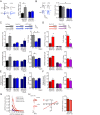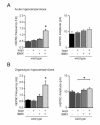Synaptic plasticity through activation of GluA3-containing AMPA-receptors
- PMID: 28762944
- PMCID: PMC5578739
- DOI: 10.7554/eLife.25462
Synaptic plasticity through activation of GluA3-containing AMPA-receptors
Abstract
Excitatory synaptic transmission is mediated by AMPA-type glutamate receptors (AMPARs). In CA1 pyramidal neurons of the hippocampus two types of AMPARs predominate: those that contain subunits GluA1 and GluA2 (GluA1/2), and those that contain GluA2 and GluA3 (GluA2/3). Whereas subunits GluA1 and GluA2 have been extensively studied, the contribution of GluA3 to synapse physiology has remained unclear. Here we show in mice that GluA2/3s are in a low-conductance state under basal conditions, and although present at synapses they contribute little to synaptic currents. When intracellular cyclic AMP (cAMP) levels rise, GluA2/3 channels shift to a high-conductance state, leading to synaptic potentiation. This cAMP-driven synaptic potentiation requires the activation of both protein kinase A (PKA) and the GTPase Ras, and is induced upon the activation of β-adrenergic receptors. Together, these experiments reveal a novel type of plasticity at CA1 hippocampal synapses that is expressed by the activation of GluA3-containing AMPARs.
Keywords: AMPA-receptor; GluA3; cAMP; hippocampus; mouse; neuroscience; plasticity.
Conflict of interest statement
No competing interests declared.
Figures





















References
-
- Adamczyk A, Mejias R, Takamiya K, Yocum J, Krasnova IN, Calderon J, Cadet JL, Huganir RL, Pletnikov MV, Wang T. GluA3-deficiency in mice is associated with increased social and aggressive behavior and elevated dopamine in striatum. Behavioural Brain Research. 2012;229:265–272. doi: 10.1016/j.bbr.2012.01.007. - DOI - PMC - PubMed
MeSH terms
Substances
LinkOut - more resources
Full Text Sources
Other Literature Sources
Molecular Biology Databases
Miscellaneous

